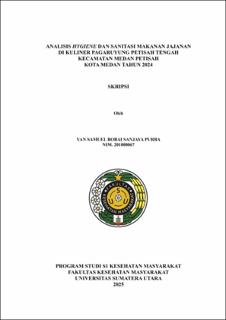| dc.description.abstract | Street food is a popular dietary choice for the public, often consumed directly in public spaces. However, if it does not meet hygiene and sanitation standards, street food can become a source of disease transmission. This study aims to analyze the application of hygiene and sanitation practices among street food vendors at Pagaruyung Petisah tengah culinary Medan Petisah Sub-District, using a descriptive observational method with a cross-sectional design. Data were collected through observations and interviews with 20 vendors, covering aspects of ingredient selection, storage, processing, transportation, and food presentation.The results revealed that sanitation standards were not optimally implemented according to the Indonesian Minister of Health Regulation No. 2 of 2023. A total of 25% of vendors used leftover ingredients, and only 45% stored ingredients at the recommended temperature. None of the vendors stored raw animal-based ingredients at the appropriate temperature, and only 25% maintained cleanliness in storage areas. In the processing stage, 90% of vendors washed ingredients with running water, but none used personal protective equipment. Additionally, 30% of vendors mixed ingredients with potential cross-contamination risks during storage. Regarding transportation, only 30% of transportation equipment was free from contamination, and in the serving process, only 25% of vendors used closed containers. Laboratory tests revealed the presence of Escherichia coli in boiled noodles and fruit soup, each at 23 MPN/100 ml, while oxtail soup exceeded 23 MPN/100 ml, and fruit juice approached the safe limit with 3.6 MPN/100 ml, where the safe limit for E. coli bacteria is <3.6 MPN/100 ml. The only item meeting the safety standard is the gulai fish, which has an E. coli content of <1.1 MPN/100 ml. These findings indicate a high risk of food contamination due to inadequate sanitation practices. This study emphasizes the importance of education and training for vendors on proper sanitation procedures, as well as strict oversight by relevant authorities to ensure food safety in this culinary area. | en_US |


